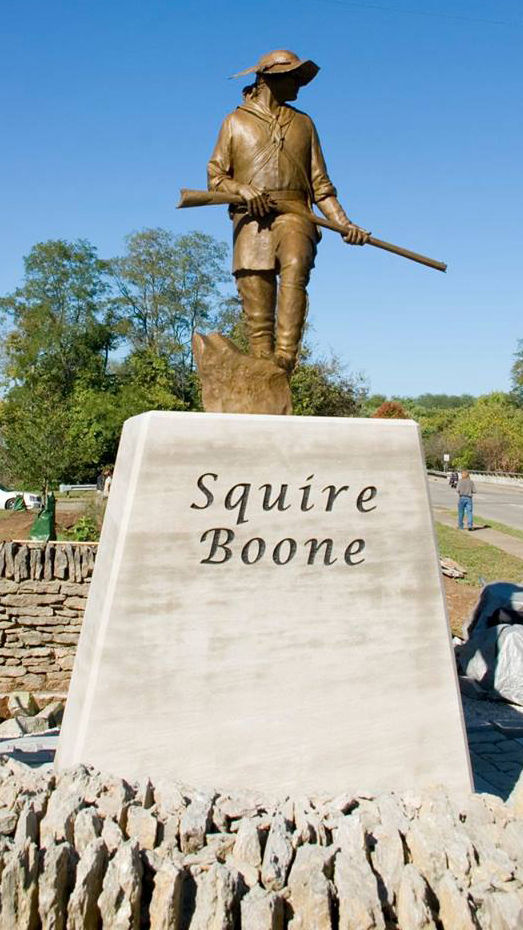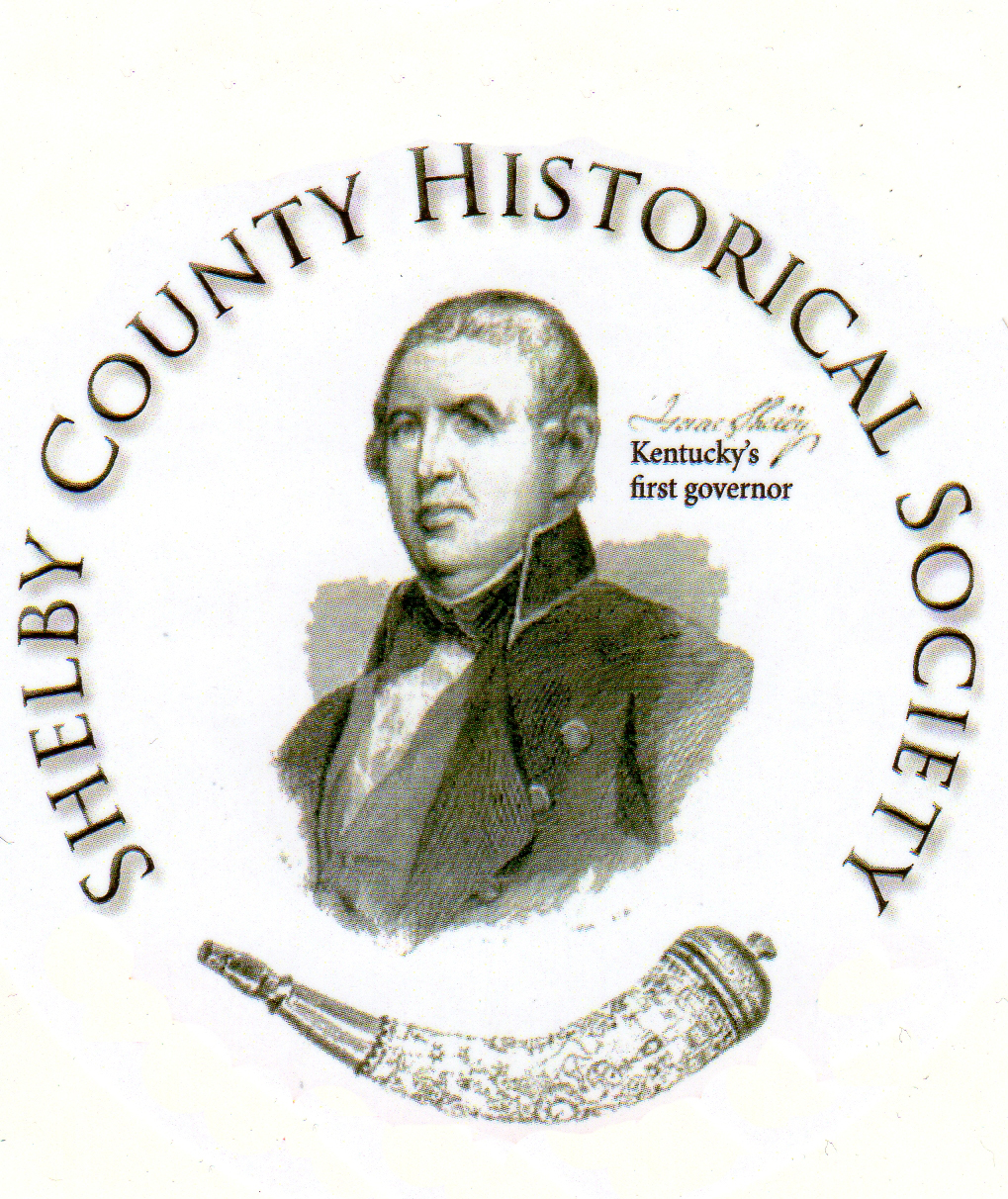
The Squire Boone Statue on East Main St.
Squire Maugridge Boone, Jr. (October 5, 1744 – August 5, 1815) left his mark on Shelby County and Kentucky history. He is best remembered for establishing a station along the banks of Clear Creek in a very pivotal era of Shelby County’s rich history. Settling Painted Stone Station in 1779/1780, Squire was one of the founding fathers of the county along with many other brave souls who ventured into the western lands of what became Kentucky. He played a pivotal role in the formation of the 12th county of Kentucky.
In honor of his accomplishments, a statue was created in his honor by sculptor Raymond Graf. A committee was formed to oversee the project, several members being members of the Shelby County Historical Society. Its dedication in 2018 drew over 100 descendants to Shelby County for a reunion and tribute to Daniel Boone’s younger brother. A crowd gathered at Centenary United Methodist Church, whose heritage also has Painted Stone ties. The Boone Society held its National Reunion and Conference on June 20-24, 2018 in Lexington with a special event in Shelbyville on June 21 to celebrate the placement of the statue. Members placed a wreath at the statue on East Main Street to mark the significance of Squire Boone’s efforts to establish Shelby County, as well as Kentucky.
With many members world-wide, The Boone Society Inc. is an association of descendants, genealogists, and historians who enjoy studying the lives and times of this remarkable family. It was formed as a reference service for researchers, a conduit for genealogists, clearing-house for bibliographical works, and to host the biennial Boone Family Reunion.
Squire Boone statue draws over 100 descendants to Shelby County for reunion and tribute. Folks gathered at Centenary United Methodist Church whose heritage has Painted Stone ties, too. Music by multi talented Reginald Bareham.
Squire was the son of Sarah Jarman Morgan and Squire Boone, Sr. – Squire being a name, not a title. He was born in Exeter Township, Berks County, PA, while Squire, Sr. was a native of Devon, England. In 1749, the family left Pennsylvania and settled in the Yadkin Valley area of Rowan County, North Carolina. In 1759, aged 15, he returned to Pennsylvania to apprentice as a gunsmith under his cousin Samuel Boone. After five years of apprenticeship, he returned to North Carolina.
Squire married Jane Van Cleave on August 8, 1765 and they had five children. Squire was at Ft. Boonesboro in September 1778 during the Great Siege where he used his talents as an artisan and gunsmith to fashion two wooden cannons from black gum tree trunks banded by iron wagon wheels. Squire was a man of the times, very clever, and very driven. After the Siege, he and his family lived at the Falls of the Ohio, the area that would become Louisville, for a time.
He was a longhunter, soldier, city planner, politician, land locator, judge, politician, gunsmith, miller, and even a preacher. It is said he performed the first marriage ceremony in what would become Kentucky on August 7, 1776 at Fort Boonesboro. Wherever older brother Daniel went, Squire was not far behind. As Shelby County Historical Society member Ted Igleheart pointed out in “Squire Boone The Forgotten Man”, Squire “did not have a John Filson to record his exploits and make him a legend as did his older brother, Daniel.” But he survived those exploits just the same.
Squire first came to Shelby County in 1775-1776. He had made several trips into what would become the state of Kentucky, taking provisions and ammunition to Daniel. He accompanied Daniel on several longhunts between 1767 and 1771. In 1775, when Richard Henderson hired Daniel Boone to blaze the Wilderness Road through the Cumberland Gap and into central Kentucky, Squire was by his side. Squire accompanied his brother and 30 other men, assisting in the settlement of Boonesborough.
Squire fought in many hand-to-hand combats during the American Revolution. He had settled his own Painted Stone Station during these turbulent years by the spring of 1780. He had previously visited the site and planted a corn crop, as was required for a pre-emption before settling a tract of land. He carved his name and date on a stone and painted the letters red. From this effort the location took on the name Painted Stone Station.
Squire was Captain over command of a unit of 23 Militia men at his fort. A year after establishing the fort with 13 families, it was attacked in April 1781 by marauding Native Americans. Known as the first permanent settlement in the county, it was still exposed and an easy target for Natives. After several encounters with the Natives, the settlers decided to abandon the station and relocate to nearby Linn’s Station in September of that year. The settlers were attacked halfway there, on September 13, 1781, in what became known as the Long Run Massacre.
Squire had been wounded during the early April attack on the station and his right arm became an inch and a half shorter than his left arm as a result. Because Squire was still too weak from his injury to make the trip, he stayed behind at the station with one other family. Survivors of the Long Run Massacre documented their escape and every September in Shelbyville a re-enactment takes place, dedicated to their memory. Many Low Dutch settlers, who lived in nearby Henry County, were among them as well.
In 1782, Squire began acting as a land locator for wealthy land speculators who did not want to personally risk living on the frontier. However, like his famous brother, he lost property due to risky investments and land deals, including his Painted Stone Station. Squire served two terms in the Virginia legislature in 1789 and 1790 and was the primary sponsor of a bill to charter the town of Louisville. On May 1, 1780, the Virginia Legislature passed an act to establish Louisville.
After a foray into Mississippi and Missouri, he eventually settled with his family in Harrison County, Indiana, south of Corydon around 1804. The flourishing settlement became known as Boone Township. He acquired a large tract of land on the western edge of the township near a cave he and Daniel had hid in many years earlier to escape Native Americans. Considering the cave to be sacred, he decided that was where he wanted to be entombed.
On his land, Squire carved stone out of a nearby hill to build his home, also carving out various religious and political statements that are still there today. He also built Old Goshen Church, one of the first churches in the state.
Squire Boone died of congestive heart failure, at age 70, and was buried as he requested in the cave on his property in Harrison County, Indiana. He had carved his own walnut coffin. The cave was sealed by his sons and his remains were left undisturbed for many years. The cave was eventually brought under local guardianship and became a commercial attraction known as Squire Boone Caverns. In 1973, his remains were removed from the cave and placed in a new coffin and reburied in a recessed part of the cave. Some say his son Enoch later removed his body and reburied his father on his farm (near Fort Knox, KY) next to Squire’s wife, Jane. While others remember his famous brother, Squire has not been overlooked by Shelby County, KY.
